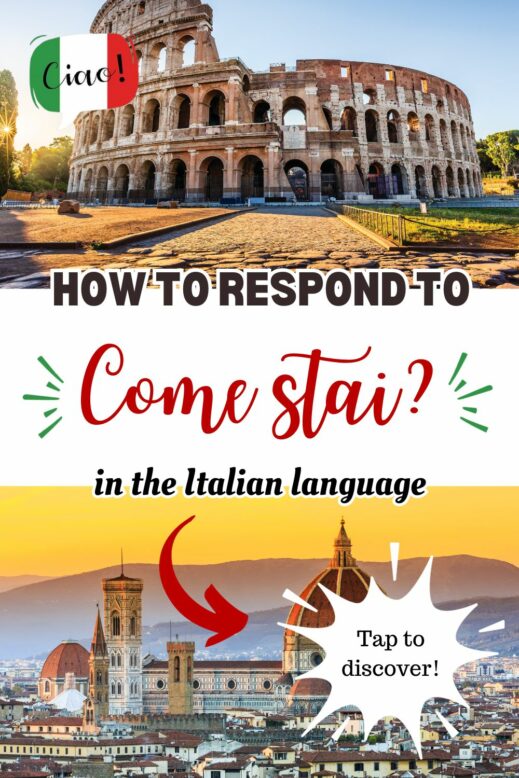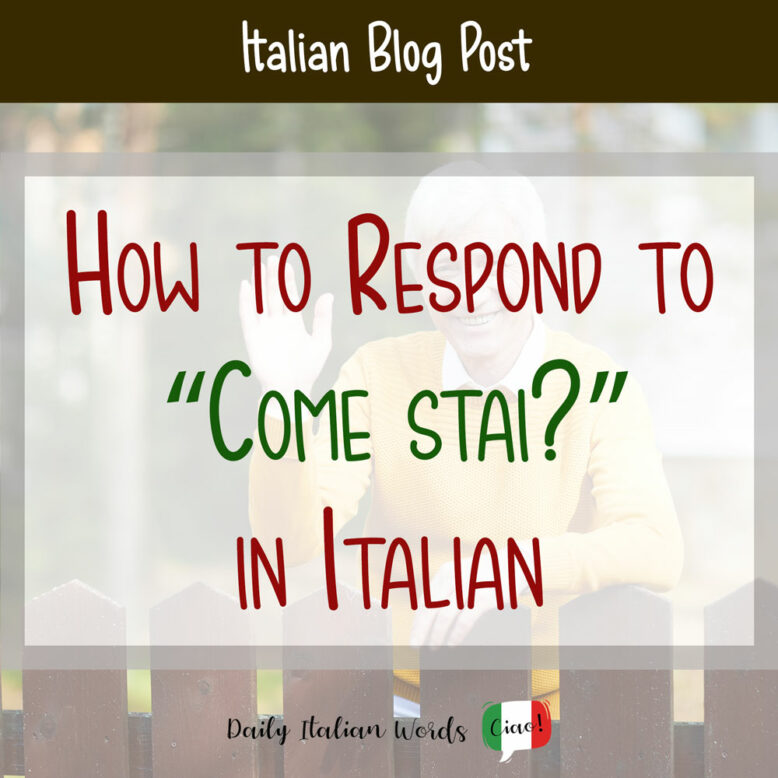If someone asks the question “How are you?” in Italian, which normally translates as Come stai? (informal) or Come sta? (formal), there are various ways you can respond depending on your mood or the situation.
In this article, we’ve covered all the most common responses, listed in order from the most to least positive, and shared extra information at the end. Buona lettura! (Happy reading!)
Note: For all the examples below, you can either repeat the verb in your response or skip the verb. For example:
Sto molto bene, grazie. = I’m very well, thanks.
Molto bene, grazie. = Very well, thanks.

1. Da dio! / Alla grande! / Una favola!
If you’ve never felt better in your life, you can express your satisfaction by answering with Da dio (lit. like god, or in a godly way), alla grande (great / really great), una favola (like being in a fairy tale) or even una meraviglia (magnificently).
Come stai oggi? – Una favola! Ho appeno superato l’esame con trenta e lode!
How are you today? – Amazing! I just passed the exam with full marks!
Keep in mind that these are commonly used in colloquial conversations, especially between friends or family members. You wouldn’t use them in formal situations or with a person you don’t know.
2. Benissimo! / Molto bene!
The most formal response you can give is Benissimo! or Molto bene! both of which translate as Very good! or Very well!
Either may be preceded by sto, the first-person singular present indicative of the verb stare (to stay / be).
Come stai? – Sto benissimo, grazie!
How are you? – I’m very well, thanks!
Another variation is benone, the augmentative of bene, which means very well too. It’s a more informal and friendly way of responding to the question.
You can add to the enthusiasm of your response by saying mai stato/a meglio which means never felt better.

3. Bene!
One step down from benissimo is the word from which it derives: bene, meaning well or good. Bene, or sto bene, is easily one of the most common responses to come stai that you’ll hear and use.
Alternatives include tutto bene, tutto a posto (everything all right, all good) or tutto ok (everything ok).
Come stai? – Sto bene. E tu? – Tutto a posto, grazie.
How are you? – I’m well. And you? – All good, thanks.
4. Abbastanza bene.
By adding the adverb abbastanza (sufficient, enough, quite) in front of bene, you get the equivalent of the English responses quite well, fairly well or pretty good.
Come stai? – Mah, sto abbastanza bene, tutto sommato.
How are you? – Fairly good, all things considered.
Depending on your mood, a curious person might answer back with: Solo abbastanza? (Only quite?).
An alternative is to stick with bene and either use a half-hearted inflection or fillers such as mah, tutto sommato, direi, dai.
Come stai? – Mah, bene direi, non mi posso lamentare troppo.
How are you? Good, I suppose, I can’t complain too much.
5. Non c’è male.
Non c’è male literally means there isn’t bad but as a response, it translates as not bad or not too bad. It hovers around the level of abbastanza bene in terms of enthusiasm.
Come stai oggi? – Non c’è male, grazie.
How are you today? – Not bad, thanks.
You can also use the following alternatives:
- Niente male = not bad or not bad at all, which sounds more positive
- Non mi posso lamentare = I can’t complain

6. Così così.
Così così is how you would say so-so in Italian.
Come stai? – Mah, così così. Ho avuto una giornata un po’ faticosa.
How are you? – So-so. I had a bit of a tiring day.
A synonym for così così can be insomma, or you can use both of them together (insomma, così così). In that case, the translation would be well, so-so / all in all, so-so.
You can also use the phrase Ho visto giorni migliori (I’ve seen better days).
Come stai? – Insomma, così così. Ho visto giorni migliori.
How are you? – Well, so-so. I’ve seen better days.
7. Non sto (molto) bene.
If you want to be blatantly honest about how you’re feeling, you can use the response non sto bene (I’m not well / not doing great) or non sto molto / troppo bene (I’m not very well / not doing all that great).
Come stai? – Onestamente, non sto molto bene.
How are you? – Honestly, I’m not very well / not doing great.
By adding per niente onto the end, you get the phrase non sto bene per niente (I’m not at all well).
8. Sto male. / Sto malissimo.
The response sto male (I’m unwell / poorly) and the even more emphatic sto malissimo (I feel really unwell / poorly) should only be used if you truly feel unwell and are in need of assistance. Otherwise you might come across as an attention seeker! Note that in English, we usually say I feel awful / terrible instead of I’m unwell.
Come stai? – Uhh, sto male. Devo aver mangiato qualcosa che mi è rimasto sullo stomaco.
How are you? – Uhh, I feel awful. I must have eaten something that didn’t agree with me.

9. Da cani / Uno schifo / Uno straccio
If you want to use some figurative expressions to say that you feel really awful, you can try using:
- (Sto) da cani (lit. like a dog)
- (Sto) uno schifo (schifo means disgusting, revolting)
- (Sto) uno straccio (straccio means rag but also worn out)
Come stai? – Uno schifo! Ho la febbre alta e mi fa male dappertutto.
How are you? – I’m a mess! I have a high fever and my whole body hurts.
Other ways of asking and responding
Come stai? is not the only popular way to ask somebody how he or she is.
Another phrase that is equally popular is Come va?, which translates to How’s it going? in English. It is a bit more informal but it means the same thing.
You can also choose other phrases such as:
- Si tira avanti = I’m / We’re getting by
- Come al solito = As usual
- Diciamo che va bene = Let’s say I’m ok
- In forma, grazie = I’m well, thanks (literally “in shape”)
Ciao Marco, come va? – Molto bene grazie, e tu? – Insomma, si tira avanti.
Hi Marco, how’s it going? – Very well thanks, and you? – Well, I’m getting by.

Heather Broster is a graduate with honours in linguistics from the University of Western Ontario. She is an aspiring polyglot, proficient in English and Italian, as well as Japanese, Welsh, and French to varying degrees of fluency. Originally from Toronto, Heather has resided in various countries, notably Italy for a period of six years. Her primary focus lies in the fields of language acquisition, education, and bilingual instruction.


